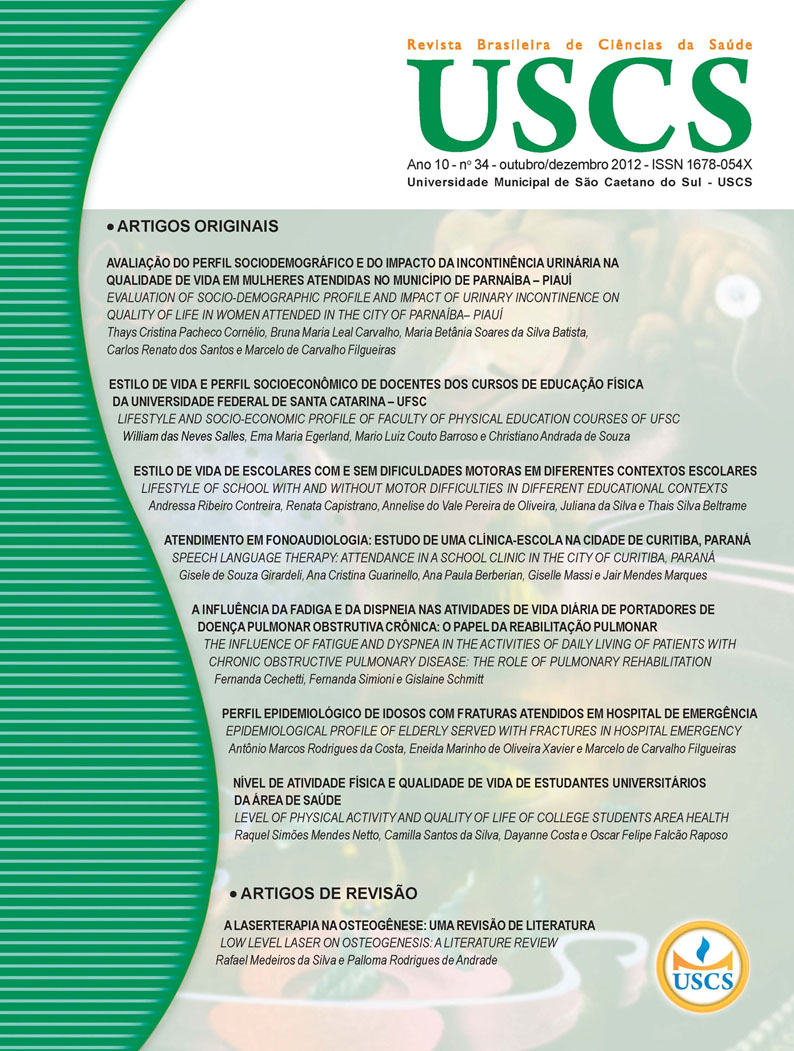A INFLUÊNCIA DA FADIGA E DA DISPNÉIA NAS ATIVIDADES DE VIDA DIÁRIA DE PORTADORES DE DOENÇA PULMONAR OBSTRUTIVA CRÔNICA: O PAPEL DA REABILITAÇÃO PULMONAR
DOI:
https://doi.org/10.13037/rbcs.vol10n34.1753Palavras-chave:
Fisioterapia, Reabilitação PulmonarResumo
Contextualização: A doença pulmonar obstrutiva crônica (DPOC) pode ser descrita como uma doença de caráter obstrutivo que gera limitação crônica ao fluxo aéreo, caracterizada por sinais e sintomas clínicos a dispnéia e a fadiga. A fim de melhorar a capacidade funcional do paciente dispomos do programa de reabilitação pulmonar. Objetivos: Este trabalho tem por objetivo verificar se há diferença entre o grau de dispnéia e de fadiga durante a realização das atividades de vida diária de idosos portadores de DPOC que realizam um programa de reabilitação pulmonar com idosos que não realizam. Métodos: Participaram deste estudo 31 idosos com diagnóstico de DPOC e idade superior a 60 anos. Destes, 17 eram participantes de um grupo de reabilitação pulmonar e 14 não participantes. Foram utilizados para coleta de dados as versões brasileiras das escalas London Chest Activity of Daily Living e Medical Research Council e do questionário Pulmonary Functional Status and Dyspnea Questionnaire. Resultados: Após a análise, foi encontrado uma influência negativa da fadiga e da dispnéia durante as atividades de vida diária (AVD´s) do grupo que não realiza a RP. Conclusão: Assim podemos sugerir que o programa de reabilitação pulmonar demonstra-se efetivo, promovendo uma melhor condição física do paciente portador de DPOC, diminuindo seu grau de fadiga e dispnéia, auxiliando na sua capacidade funcional.
Downloads
Downloads
Publicado
Edição
Seção
Licença
Proposta de Política para Periódicos que oferecem Acesso Livre Adiado
Autores que publicam nesta revista concordam com os seguintes termos:
- Autores mantém os direitos autorais e concedem à revista o direito de primeira publicação, com o trabalho licenciado simultaneamente sob uma licença
https://creativecommons.org/licenses/by-nc-nd/4.0/, permitindo o compartilhamento do trabalho com reconhecimento da autoria do trabalho e publicação inicial nesta revista.
- Autores têm autorização para assumir contratos adicionais separadamente, para distribuição não-exclusiva da versão do trabalho publicada nesta revista (ex.: publicar em repositório institucional ou como capítulo de livro), com reconhecimento de autoria e publicação inicial nesta revista.
- Autores têm permissão e são estimulados a publicar e distribuir seu trabalho online (ex.: em repositórios institucionais ou na sua página pessoal) a qualquer ponto antes ou durante o processo editorial, já que isso pode gerar alterações produtivas, bem como aumentar o impacto e a citação do trabalho publicado (Veja O Efeito do Acesso Livre).









